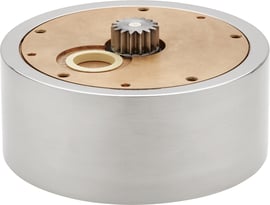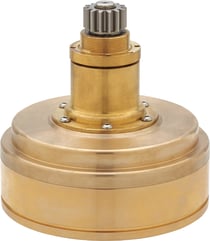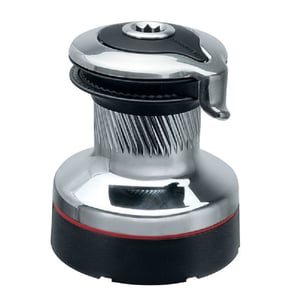
Choosing a winch can be daunting. The main decision criteria may be size or power Ratio, but Style, Speeds, Material and Grip are also of a consideration. That’s without going into powered options (electric / hydraulic), and then an extensive range of winch handle styles and sizes! Winches are an expensive bit of equipment and an educated choice will save you from unnecessary spend.
Leverage, Gearing and Power
Leverage is generated by the larger radius of the turning circle of the handle compared with the radius of the winch drum.
A 254mm winch handle turning a 60mm radius drum will generate a power ratio of

Which multiplies the sailor’s pulling power by a factor of 8.5.
N.B. in practice, some of this theoretical power will be lost to friction in the handle and internal winch mechanism.
Geared winches increase the power ratio by increasing the number of handle turns needed to turn the winch drum. A 3:1 gear will increase the pulling power on a line by a factor of 3 compared with a non-geared winch. Do bear in mind that higher strength equals less speed!
A 254mm winch handle turning a 60mm radius 3:1 geared drum will generate a theoretical power ratio of:



For example, take the Harken 40.
It has a drum diameter of 80mm and a gear ratio of 6.28 in its highest, most powerful, second gear.


The Andersen 40 by comparison, has a Drum diameter of 75mm and second gear ratio of 6 which achieves the same overall Power ratio as the wider Harken 40 drum.
Ok, great formulas and all...
Some might say: “go with the biggest you can afford”, but, too much power can overload other deck hardware systems. In reality, it should be “big enough to do the required job”.
Manufacturers provide sizing guides, meaning you don’t have to calculate the power required to haul the sail. The criteria used differs among manufacturers, making comparisons between brands difficult. Some use solely boat length whilst others use estimated sail sizes plus boat and/or rig specifications.
See recommendations from four different manufacturers for genoa, main and spinnaker sheet winches below:

Question: What do these significantly different recommendations tell us?
Answer: It is a relatively subjective decision!
The differences here between Harken and Andersen probably reflect their different attitudes to performance and what power is required to “effectively” pull in a 25m² genoa. With a more race-orientated background, Harken recommend more power for an equivalent sized sail compared to Andersen whose clients are more cruising orientated.
Some differences are down to how each manufacturer has generalised between masthead vs fractional rigs, assumed purchase ratio on the mainsheet and averaged I, J, P and E rig data. There are also significant differences in loads on halyards and sheets for heavy cruising boats vs. light displacement race boats, mono-hulls and multihulls which is why its difficult to generalise.
Conclusion
The key take-away here is that these are only guides; your final decision should come down to consideration of your boat type, your sailing style and the capabilities of your crew. If you have a relatively standard medium displacement mono-hull and the plan is to gently potter, reverting to the engine when increased winds make the going tough, you may be able to go to the smaller end of the recommended ranges.
If you are a racer or the hardy type that will reef down and carry on regardless, then you should look towards the larger end of the recommended ranges. Also consider the abilities of the people you will be sailing with, not just yourself. If you intend these winches to last a long time, bear in mind that your pulling power may decrease over time (!), and a larger winch size will help “future-proof” your boat.
If you have any questions about manual winches, please feel free to email us at support@upffront.com, or click the link below to see our full range:



